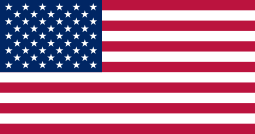
Back Vlag van die Verenigde State Afrikaans የአሜሪካ ሰንደቅ ዓላማ Amharic علم الولايات المتحدة Arabic علم الولايات المتحده ARZ Bandera de los Estaos Xuníos d'América AST ABŞ bayrağı Azerbaijani آمریکا بیرلشمیش ایالتلرینین بایراغی AZB Kobér Amérika Serikat BAN Bandera kan Estados Unidos BCL Сцяг ЗША Byelorussian
 | |
| Other names | The American flag,
|
|---|---|
| Use | National flag and ensign |
| Proportion | 10:19 |
| Adopted |
|
| Design | Thirteen horizontal stripes alternating red and white; in the canton, one white star for each state (50 stars as of 1960) arranged in horizontal rows (of alternating numbers of six and five stars per row as of 1960) on a blue field |
The national flag of the United States, often referred to as the American flag or the U.S. flag, consists of thirteen horizontal stripes, alternating red and white, with a blue rectangle in the canton bearing fifty small, white, five-pointed stars arranged in nine offset horizontal rows, where rows of six stars alternate with rows of five stars. The 50 stars on the flag represent the 50 U.S. states, and the 13 stripes represent the thirteen British colonies that won independence from Great Britain in the American Revolutionary War.[1]
The flag was created as an item of military equipment to identify US ships and forts. It evolved gradually during early American history, and was not designed by any one person. The flag was mostly unknown to the American public until 1861, when it exploded in popularity as a symbol of opposition to the Confederate attack on Fort Sumter. It came to symbolize the Union side of the American Civil War; Union victory solidified its status as a national flag. Because of the country's emergence as a superpower in the 20th century, the flag is now among the most widely recognized symbols in the world.
Nicknames for the flag include the Stars and Stripes, Old Glory, and the Star-Spangled Banner. The Pledge of Allegiance and the holiday Flag Day are dedicated to it. The number of stars on the flag is increased as new states join the United States. The last adjustment was made in 1960, following the admission of Hawaii.
- ^ Warner, John (1998). "Senate Concurrent Resolution 61" (PDF). U.S. Government Printing Office. Archived (PDF) from the original on May 6, 2009. Retrieved April 5, 2014.